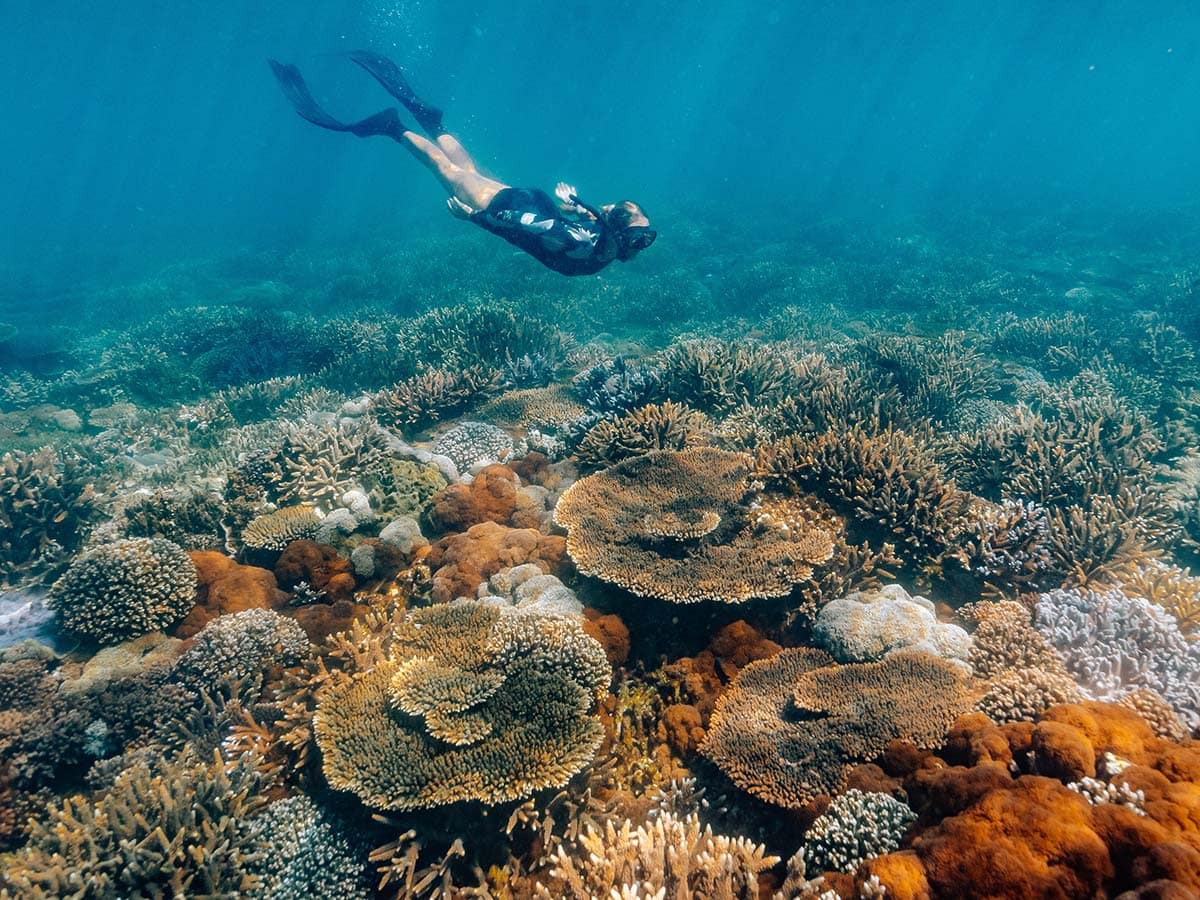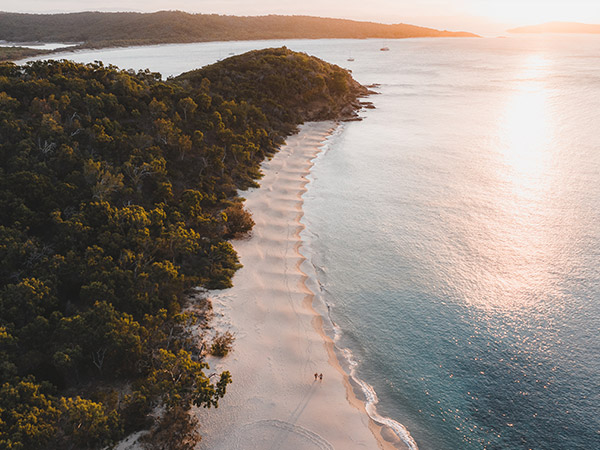14 May 2024
![]() 5 mins Read
5 mins Read

A plethora of activities await on the low-key, barefoot paradise of Great Keppel Island. Hang with a crowd or get away from it all to peaceful coves and sheltered bays surrounded by the Great Barrier Reef Marine Park.
As one of the one the most affordable islands to visit on the Great Barrier Reef, you can swim, snorkel, dive and more in what are arguably some of Australia’s best beaches. It’s not all ocean-based fun though, with incredible bushwalks and birdwatching available on land.

Enjoy the view from land or sea. (Image: TEQ)
Great Keppel (Wop-pa in the language of the Kanomi-Woppaburra people) is a diverse and diverting place to stay for all ages, a truly beautiful escape from the rest of the world.
Fly into the region with direct flights from Brisbane, Sunshine Coast, Melbourne, Cairns, and Townsville to Rockhampton Airport. Then it’s just a shuttle bus to Yeppoon where ferries depart regularly from Keppel Bay Marina and Pier One at Rosslyn Bay.
Within 30 minutes, you’ll feel the sand between your toes on Great Keppel Island and instantly relax. Go barefoot – there’s no jetty on the island, so your first step off the ferry will be onto the sand (don’t worry, there are helping hands to help you disembark). Day tours also run from Rosslyn Bay for those who are short of time.

Getting to Great Keppel Island is easy, getting around once you’ve arrived is even easier.
There’s no problem finding somewhere to stay on Great Keppel, with accommodation to suit all budgets and tastes. Pitch a tent, or stay in a cabin, a motel-style room or a private beach house.
There are two major accommodation providers, Great Keppel Island Holiday Village and Great Keppel Island Hideaway. Both are low-key, relaxed and close to the beach. Great Keppel Island Holiday Village is self-catering, but Great Keppel Island Hideaway has a bar and bistro, sometimes with live music or other entertainment.

Enjoy incredible views from Great Keppel Island Hideaway’s Beachfront Cabins.
Walk off the beach and snorkel the reef. It’s that easy on Great Keppel. And you’ve got 17 beaches to choose from. Among the best snorkelling spots are Shelving Beach, Monkey Beach and Clam Bay, where you’ll be amazed at the rich array of turtles, corals and other marine life. You might even spot a dolphin or dugong.
As well as an array of water sports offered by Keppel Dive & Snorkel (think stand-up paddleboarding, kayaking and more), there is a network of hiking trails to explore. Keen fishermen can cast a line straight off the beach (but be aware there are no-fishing zones, so check your location first).
Or, of course, you could do nothing at all. Great Keppel’s that kind of place too. Hammock, anyone?

Head to Keppel Dive & Snorkel for underwater adventures. (Image: TEQ)
Getting onto the water is easy on Great Keppel Island. Full-day and half-day cruises depart from Yeppoon, or try a sailing adventure. If you’re looking for tranquillity, take a guided kayak tour along Leekes Creek or hire one and go it alone.
Diving and snorkelling tours – or drop-offs to explore the reef on your own (for certified divers) – open up the underwater wonders of the southern Great Barrier Reef. Introductory dives are also available.
For those who don’t want to get wet, Freedom Fast Cats runs glass-bottom boat tours as well as a range of other cruises. Whale-watching tours are offered in season (July – September) when you can see the majestic Humpback whales on their migratory path along the Queensland coast.

Go snorkelling or diving with providers like Keppel Explorer and Keppel Dive and Snorkel. (Image: TEQ)
When British explorer Captain James Cook sailed past the island in 1770, the islands of Keppel Bay had been home to the Kanomi-Woppaburra people of the Darumbal nation for around 5000 years. Ancient shell middens can still be found on the island, a reminder of the abundant seafood they harvested from the ocean.
Captain Cook named the bay for his boss, Rear Admiral Augustus Keppel, but it was not until the 1860s that European settlers moved onto the island.
On the northern side of the island, you can walk to the 1920s homestead occupied by the Leeke family still stands. Now heritage-listed, the tin house overlooks the tidal mangroves and Leeke’s Beach. If you’re particularly energetic and have a day to spare, hike the 15km round-trip to the island’s lighthouse at Bald Rock Point.

Explore the islands walking trails.
For an introduction to what you might see in the waters surrounding Great Keppel, follow the short GKI Sea Way Trail which starts on the lawns overlooking The Spit at Fisherman’s Beach.
The boardwalk winds through Great Keppel Island Hideaway’s grounds and features 15 colourful information panels, each one in the shape of a marine animal. The trail is an initiative of the Keppel Turtle Fund, a local charity focused on education, appreciation, protection, and rehabilitation of the marine environment.

Take in the sunset on an island walk.
Sea turtles breed and feed around the island. From November to March, you might be lucky enough to spot a nesting turtle or hatchlings heading to the sea to start their life’s journey.
On land, you won’t wait long to encounter some of the island’s incredible wildlife, including echidnas, goannas, blue-tongue lizards, possums and a rich array of birdlife. More than 100 species of birds live here, including kookaburras, rainbow lorikeets, sea eagles, curlews, honeyeaters and more.

Go hiking or just stay still and let the wildlife come to you. (Image: TEQ)
LEAVE YOUR COMMENT